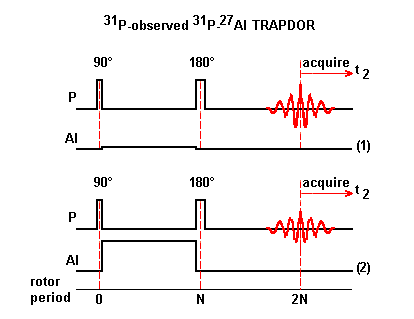TRAnsfer of Population in DOuble Resonance
Grey and coworkers designed TRAPDOR sequence which uses the heteronuclear dipole coupling between quadrupole and spin-1/2 nuclei to ascertain connectivity and spatial interaction information. It facilitates the recoupling of quadrupole spins in Zeeman states other than ¦±1/2>.

Both the 31P 180° pulse and the start of the acquisition are synchronized with the rotor echoes. The 27Al spins are irradiated for one half of the echo period of Scheme (2), with Scheme (1) providing the blank period.
In Scheme (2), the continuous irradiation of the 27Al nuclei during N rotor periods modifies the Zeeman population levels of the 27Al spin, which in turn affects the magnetization of the 31P nuclei dipole coupled to it.
Lang and coworkers suggested that to minimize variations in experimental conditions and eliminate spectrometer timing artifacts, 27Al decoupling pulse should be triggered in both schemes with minimal offset, from very high power attenuation in Scheme (1) for no 27Al irradiation to low power attenuation for maximum 27Al irradiation in Scheme (2). In other words, the sequences in Schemes (1) and (2) should be applied on alternate scans to avoid any instrument instabilities affecting the outcome of the experiments.
As in SEDOR experiment, a normalized TRAPDOR difference
signal, defined as
(delta S)/S0 = [signal from Scheme (1) - signal from
Scheme (2)]/signal from Scheme (1),
is plotted versus the number of rotor periods of on-resonance
27Al irradiation. The interatomic distance is
extracted by fitting these data with a theoretical curve.
The curve representing the normalized TRAPDOR difference versus 27Al offset frequency allows an estimation of the quadrupole coupling constant of 27Al.
